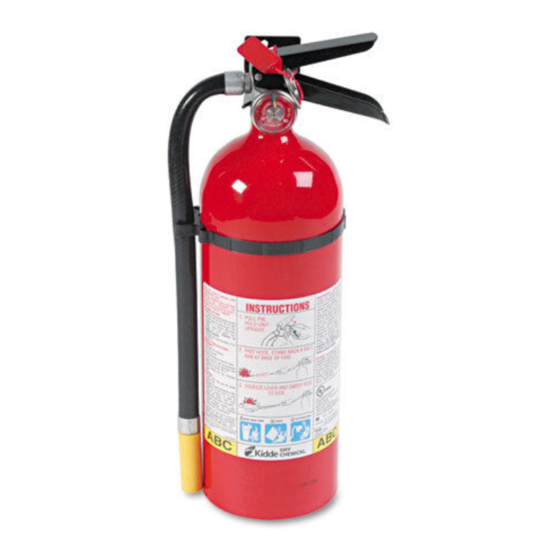Summary of Contents for Kidde Pro line
- Page 1 Service Manual Stored Pressure Dry Chemical Hand Portable Fire Extinguishers 2½ lb - 20 lb Pro Line Agent Capacity...
-
Page 2: Table Of Contents
For assistance, you may contact the nearest authorized Kidde fire extinguisher distributor. Your local distributor can be located in the phone book yellow pages, by contacting Kidde directly at (1-800-880-... -
Page 3: Introduction
These Kidde extinguisher models are stored pressure hardware designs, which utilize steel and Aluminum agent cylinders. These models are charged with various types of Kidde dry chemical agents that include Regular (Sodium Bicarbonate), Purple-K (Potassium Bicarbonate) and Multipurpose (Mono-Ammonium Phosphate). The extinguishers should only be pressurized with nitrogen. -
Page 4: Operation Instructions
2. Discharge valve assembly - consists of the operating lever, carrying handle, valve stem, pressure gauge and discharge outlet that permits the actuation and discharge of the dry chemical extinguishing agent. 3. Siphon tube assembly - houses the spring assembly and provides the means for the extinguishing agent to be drawn up from the bottom of the cylinder to the discharge valve. -
Page 5: After Use Instructions
5. Ensure pressure gauge pointer needle indicates within the green operable pressure range. 6. Heft or weigh extinguisher to determine its fullness. Note: Kidde recommends stored pressure dry chemical fire extinguishers be weighed at least semi-annually to verify the proper agent charge weight in accordance with nameplate instructions. - Page 6 Kidde fire extinguishers. Refer to the trouble shooting section of this manual for additional information on specific equipment observations or discrepancies.
- Page 7 (Newer Kidde models indicate this information on their nameplates) 6. Visually examine the cylinder valve discharge port for any signs of thread wear, corrosion, obstructions or accumulations of any foreign material.
-
Page 8: Recharge Instructions
Because of potential performance or detrimental material compatibility problems which may occur with the use of other agents, Kidde requires that only the dry chemical extinguishing agent specified on the extinguisher nameplate be utilized for recharge. - Page 9 If necessary remove extinguisher from service and replace. 10. Add the proper type and quantity of Kidde dry chemical agent specified on the extinguisher nameplate recharge instructions. 11. Reinstall the discharge valve assembly onto the agent cylinder. Ensure the valve is properly snugged down and the pressure gauge is properly orientated perpendicular to the front of the extinguisher.
-
Page 10: Hydrostatic Test Requirements
Hydrostatic Test Requirements Hydrostatic testing is the integrity pressure testing method of a vessel utilizing a liquid compression medium. Kidde dry chemical fire extinguisher cylinders require hydrostatic testing at periodic intervals or any time the integrity of the vessel is questioned from any visually observed condition. - Page 11 NFPA-10 requirements. • Never stamp or etch any markings onto the cylinder. • Any time a fire extinguisher is known to have contained agents, additives or mediums other than that specified on the nameplate, it should be removed from service and properly disposed at the owner’s...
-
Page 12: Trouble Shooting Suggestions
Total charge weight of unit outside tolerance Nameplate instructions missing or illegible Agent cylinder damaged or corroded *For gauge replacement, Kidde recommends the use of Loctite - 242 thread sealant be utilized and allowed to properly cure. Corrective Suggestion Secure, repair or replace... - Page 13 KIDDE PRO LINE STORED PRESSURE DRY CHEMICAL PORTABLE EXTINGUISHER DIAGRAM (ALUMINUM VALVE) The following spares parts are available for the Kidde Pro Line: Hose/nozzle assembly Syphon tube assembly (excludes o-ring) Valve assembly (includes handle & lever attached & valve body...
- Page 14 KIDDE PRO LINE STORED PRESSURE DRY CHEMICAL PORTABLE EXTINGUISHER DIAGRAM (ALUMINUM VALVE) The following spares parts are available for the Kidde Pro Line: Hose/nozzle assembly Syphon tube assembly (excludes o-ring) Valve assembly (includes handle & lever attached & valve body...
- Page 15 KIDDE PRO SERIES STORED PRESSURE DRY CHEMICAL PORTABLE EXTINGUISHER DIAGRAM (BRASS VALVE) The following spares parts are available for the Kidde Pro Line: Hose/nozzle assembly Syphon tube assembly (excludes o-ring) Valve assembly (includes handle & lever attached & valve body...
- Page 16 Kidde Residential and Commercial 1394 South Third Street Mebane, NC 27302-9711 (Phone 1-800-880-6788) Manual P/N- 300290 Copyright © Kidde 2005...




Need help?
Do you have a question about the Pro line and is the answer not in the manual?
Questions and answers